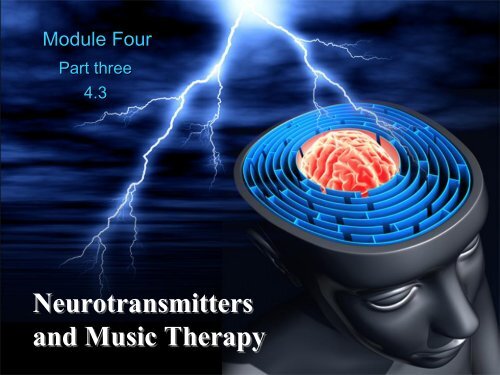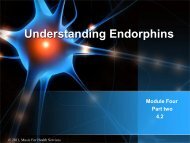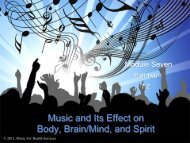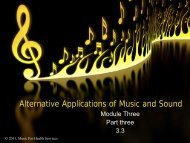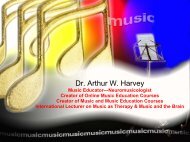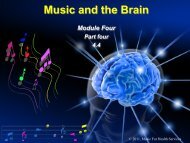Neurotransmitters and Music Therapy - Music for Health Services
Neurotransmitters and Music Therapy - Music for Health Services
Neurotransmitters and Music Therapy - Music for Health Services
Create successful ePaper yourself
Turn your PDF publications into a flip-book with our unique Google optimized e-Paper software.
Module Four<br />
Part three<br />
4.3<br />
<strong>Neurotransmitters</strong><br />
<strong>and</strong> <strong>Music</strong> <strong>Therapy</strong>
<strong>Neurotransmitters</strong> <strong>and</strong> <strong>Music</strong> <strong>Therapy</strong><br />
HOW CAN MUSIC AFFECT THE BRAIN?<br />
• <strong>Music</strong> is nonverbal so it can move through the brain's<br />
auditory cortex directly to the center of the limbic system.<br />
This system governs emotional experiences <strong>and</strong> basic<br />
metabolic responses such as body temperature, blood<br />
pressure <strong>and</strong> heart rate. It can help create new<br />
neuropathways in the brain, as well.
<strong>Neurotransmitters</strong> <strong>and</strong> <strong>Music</strong> <strong>Therapy</strong><br />
A DEFINITION OF NEUROTRANSMITTER<br />
Neurotransmitter: A chemical that is released from a nerve cell<br />
which thereby transmits an impulse from a nerve cell to another<br />
nerve, muscle, organ, or other tissue. A neurotransmitter is a<br />
messenger of neurologic in<strong>for</strong>mation from one cell to another.
<strong>Neurotransmitters</strong> <strong>and</strong> <strong>Music</strong> <strong>Therapy</strong><br />
A DESCRIPTION OF A NEUROTRANSMITTER<br />
• <strong>Neurotransmitters</strong> are chemicals made by neurons, or nerve<br />
cells. Neurons send out neurotransmitters as chemical signals<br />
to activate or inhibit the function of neighboring cells.<br />
• Within the central nervous system, which consists of the brain<br />
<strong>and</strong> the spinal cord, neurotransmitters pass from neuron to<br />
neuron. In the peripheral nervous system, which is made up of<br />
the nerves that run from the central nervous system to the rest<br />
of the body, the chemical signals pass between a neuron <strong>and</strong><br />
an adjacent muscle or gl<strong>and</strong> cell.
<strong>Neurotransmitters</strong> <strong>and</strong> <strong>Music</strong> <strong>Therapy</strong><br />
• Acetylcholine<br />
• Norepinephrine<br />
• Dopamine<br />
• Serotonin<br />
TYPES OF NEUROTRANSMITTERS<br />
• Glycine, Glutamic <strong>and</strong> Aspartic Acids, <strong>and</strong> Gamma-<br />
Amino Butyric Acid (GABA)<br />
• Peptides
<strong>Neurotransmitters</strong> <strong>and</strong> <strong>Music</strong> <strong>Therapy</strong><br />
• <strong>Music</strong> can activate the flow of stored memory <strong>and</strong><br />
imagined material across the corpus collosum (the<br />
bridge between the left <strong>and</strong> right hemispheres of the<br />
brain), helping the two to work in harmony.<br />
• <strong>Music</strong> can stimulate the immune system.<br />
• <strong>Music</strong> can excite peptides in the brain <strong>and</strong> stimulate<br />
the production of endorphins (natural opiates<br />
secreted by the hypothalamus), which produce a<br />
feeling of natural euphoria, shifting mood <strong>and</strong><br />
emotion.
<strong>Neurotransmitters</strong> <strong>and</strong> <strong>Music</strong> <strong>Therapy</strong><br />
HOW DOES MUSIC DO THIS?<br />
• <strong>Music</strong> does this by entrainment which, in the context of<br />
psychoacoustics, concerns changing the rate of brain<br />
waves, breathing, or heartbeats from one speed to<br />
another through exposure to external rhythms.
<strong>Neurotransmitters</strong> <strong>and</strong> <strong>Music</strong> <strong>Therapy</strong><br />
<strong>Music</strong> assists these medical conditions<br />
• Scientific studies have shown the positive value of music<br />
therapy on the body, mind, <strong>and</strong> spirit of children <strong>and</strong> adults.<br />
• Researchers have found that music therapy used along<br />
with anti-emetic drugs (drugs that relieve nausea <strong>and</strong><br />
vomiting) <strong>for</strong> patients receiving high-dose chemotherapy<br />
can be effective in easing the physical symptoms of nausea<br />
<strong>and</strong> vomiting.<br />
• When used in combination with pain-relieving drugs, music<br />
has been found to decrease the overall intensity of the<br />
patient's experience of pain <strong>and</strong> can sometimes result in a<br />
reduced dependence on pain medication.
<strong>Music</strong> <strong>Therapy</strong> <strong>and</strong> <strong>Neurotransmitters</strong><br />
<strong>Neurotransmitters</strong> <strong>and</strong> <strong>Music</strong> <strong>Therapy</strong><br />
• <strong>Music</strong> acts directly on the neuro-vegetative system<br />
(hypothalamus, hypophysis, suprarenal gl<strong>and</strong>s) to produce<br />
neurotransmitters. <strong>Music</strong> can reactivate those functions<br />
which due to some pathologies have been altered, giving a<br />
balance back to the body <strong>and</strong> the mind.
IN CONCLUSION<br />
• The close link between the auditory cortex, music,<br />
<strong>and</strong> the brain (specifically the neurotransmitters) is<br />
being shown in many research studies.<br />
• Learning how to use our bodies’ natural response<br />
system could reduce the population’s dependence<br />
upon possibly harmful drugs currently prescribed.<br />
• <strong>Music</strong> <strong>Therapy</strong> is an art, as well as a reputable<br />
science, based on research about music <strong>and</strong> the<br />
brain.


